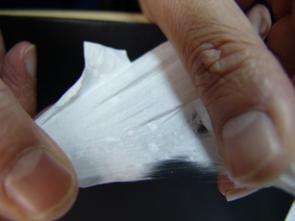Mighty Nanofibers Could Mean Stronger, Lighter Materials

Bigger may be better, but tinier is stronger. So say scientists at the Technion-Israel Institute of Technology, who have shown that tiny polymer nanofibers become much stronger when their diameters shrink below a certain size. Their research, published in the January issue of Nature Nanotechnology, could make possible stronger fabrics that use less material.
Professor Eyal Zussman and Dr. Oleg Gendelman of the Faculty of Mechanical Engineering are the first to propose an explanation for this surprising behavior in very thin fibers.
When the researchers measured the mechanical properties of nylon nanofibers, they found the critical diameter – the diameter at which the nylon nanofiber abruptly becomes stiffer—to be approximately 500 nanometers (about as thick as a spider web strand, or 100 times thinner than a human hair). They explained the abrupt increase in stiffness by considering the molecular structure inside the polymer fiber.
According to Zussman, each polymer nanofiber is made up of countless large, complex molecules called macromolecules. Macromolecules try to align themselves when the fiber is forming, but since they are so long and tangled, it is impossible for them to sort themselves out and align uniformly throughout the entire nanofiber. As a result, the nanofiber is a patchwork of differently oriented macromolecule regions. The researchers calculated the size of these regions to be roughly the same as the critical diameter of the nanofiber (the diameter at which the fiber stiffness abruptly increases).
“When the diameter of the fiber is much larger than the size of the oriented regions, the macromolecules can move relative to one another,” says Zussman. “But as the diameter of the fiber shrinks, these oriented regions become constrained and the macromolecules are unable to easily move relative to one another. So they become stuck against each other like cars in a traffic jam, and the resulting nanofiber is much stiffer.”
Although Professor Zussman and his colleagues focused on a certain type of nanofiber, they say their basic physical idea will help scientists understand the novel physical properties of a wide range of nanofibers and other nanostructures. Practical applications include lighter protective vests and stronger fabrics.
Also participating in the research, which is part of activities of the Russell Berrie Nanotechnology Institute at the Technion, were Dr. Arkadii Arinstein and graduate student Michael Burman.
Source: American Technion Society




















